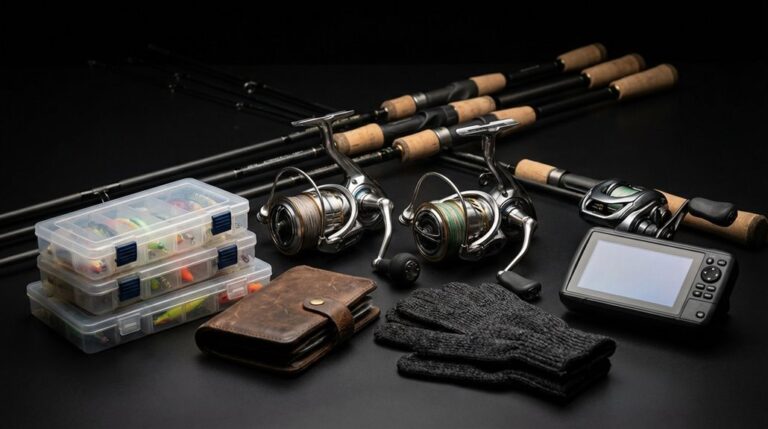Pick a line weight that falls inside or close to your rod’s rated range so the blank loads properly and you keep feel, accuracy, and longevity. Match heavier lines to big or wind‑resistant lures and lighter lines to delicate flies. Use braid for sensitivity and thin diameter, mono/fluoro for shock absorption and leader ties, and pair strong braid with a softer leader. Test knots and inspect for wear; keep going to learn practical pairings, knots, and maintenance.
Important Takeaways
- Match line weight to the rod’s rated range to preserve action, accuracy, and prevent overstressing the blank.
- Use monofilament diameter or manufacturer’s label as the baseline; braid may be stronger at smaller diameters.
- Let typical lure or fly mass guide within the rod range: lighter lines for small flies, heavier for big flies or lures.
- Pair strong braid mains with lighter mono/fluoro leaders to balance sensitivity, shock absorption, and knot security.
- Test your setup with incremental casts and static loads, inspect knots, and replace any nicked or frayed line.
Understanding Rod Line Ratings and What They Mean
Wondering what a rod’s line rating really tells you? You should see line ratings as a casting-performance guideline tied to rod power, not a strict fish-weight limit. They reflect the typical breaking strength a properly adjusted reel and rod pair work best with; monofilament diameter largely determines that number. If you swap to braid, strength can rise without much diameter change, so compatibility shifts. Running far heavier mainline or leaders than the rating stresses the rod, harming performance or causing failure, so you’ll need to adjust drag and technique. Some anglers run slightly heavier braid on lighter-rated rods, but you should do so cautiously and be prepared to alter your casting and hookup approach to avoid overloading the blank. Many species’ behavior, such as shoaling behavior, can influence line choice because schooling fish often require different tactics and line handling than solitary, territorial species.
Line Weight Vs Rod Power: Matching Strength to Action
Now that you know line ratings are a performance guideline rather than a fish-weight cap, you should match line strength to the rod’s power so the blank loads and bends as intended.
Choose a line weight that falls within or close to the rod’s specified range (for example, 12–25 lb) to preserve intended action and casting feel.
Don’t overload a light rod with heavy braid — the smaller-diameter braid can mask strength and still overstress the blank — and avoid using a far lighter line that won’t load the spine, reducing accuracy and distance.
Think of line weight as part of the system: it affects bend, stress, and leader choices.
Match strength to rod power for reliable performance and longevity.
Also consider sun-protective clothing like a UPF 50+ shirt when fishing long days to reduce UV exposure.
How Fly and Lure Size Affect Line Selection
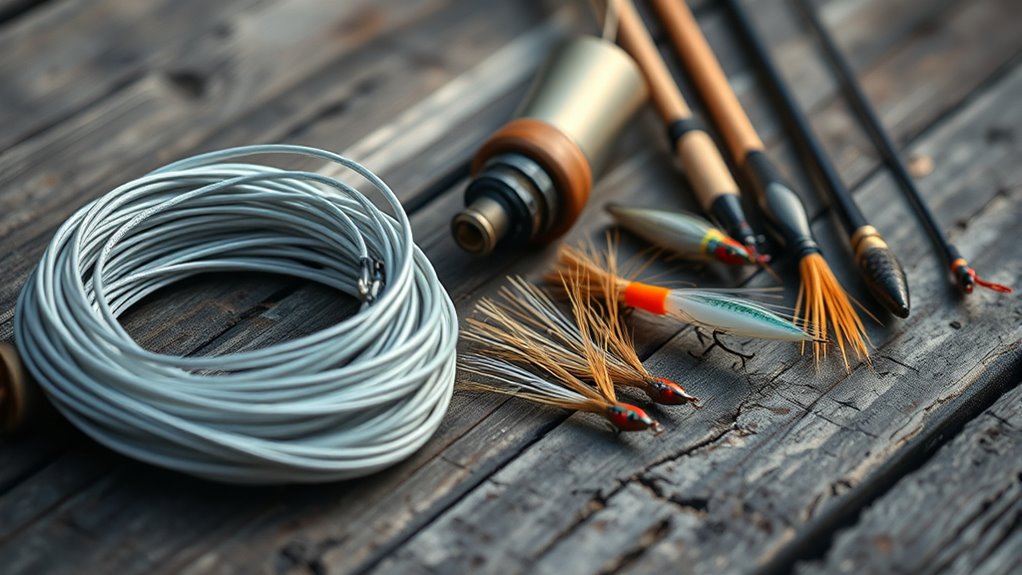
How big a fly or lure you plan to cast will directly steer the line weight you pick, since heavier patterns need more mass to load the rod and generate the line speed for accurate, efficient casts. You’ll choose heavier line weight for large or medium-to-heavy flies to maintain enough line speed and avoid skipped or luffed casts. Match that line weight to your rod’s power so you don’t overload or underload the action. For delicate, small flies you’ll favor lighter line weight to feel subtle takes and mend effectively, though you may lose distance in wind or with long leaders. In practice, let fly size guide your selection within the rod’s rated range to keep presentations smooth, accurate, and efficient. Consider how a machined aluminum housing contributes to durability when selecting tackle for both freshwater and saltwater use.
Braided, Monofilament, and Fluorocarbon: Which to Choose
Line choice doesn’t stop at weight—you also need to pick the material that best matches your presentation, leader setup, and fishing conditions. You’ll pick braided line when you want maximum sensitivity and thin diameter for the same tensile strength—UHMWPE fibers give near-zero stretch for powerful hooksets and precise control, and the slick surface reduces memory for longer, smoother casts.
Use monofilament line or fluorocarbon leaders to add shock absorption, improve bite detection, or increase sink rate; they change how the rod loads and how bites feel. Pair a stronger braid main with a weaker mono or fluro leader to balance strength and rod action. Remember braid resists wear long-term but shows abrasion and needs proper knots to keep integrity. KastKing Destron’s CFT Colorfast Technology helps prevent color fade and abrasion on many modern braids.
Wading Depth, Rod Length, and Effective Line Height
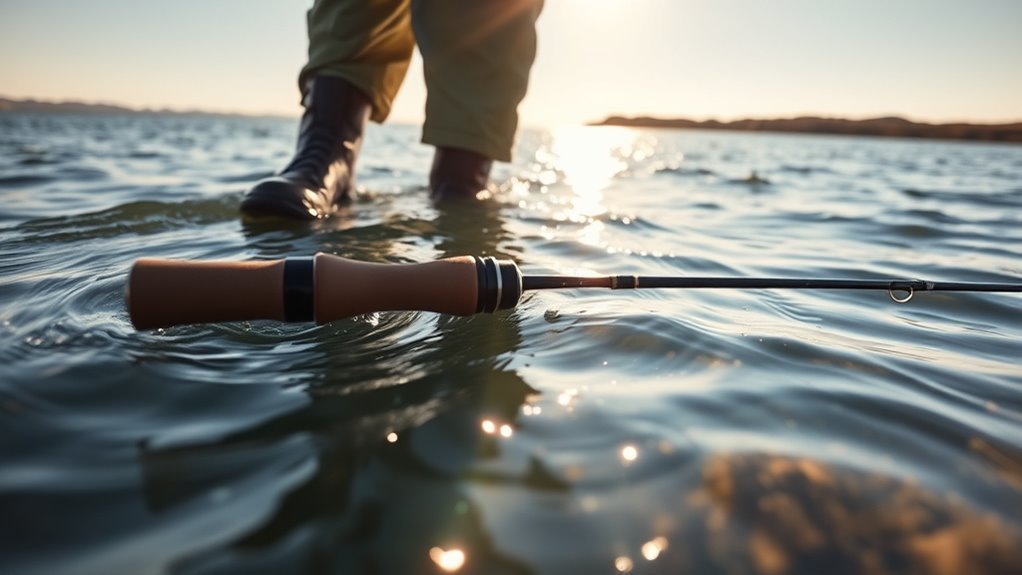
Ever wonder how far your leader sits above the water when you’re standing in it? Your effective line height drops as wading depth increases: knee-deep might work fine with a 7-foot rod, but waist-deep can shave off about two feet. That change affects line weight choices because deeper wading forces you to compensate with rod length to maintain presentation and avoid line slap on casts. Longer rods keep the line higher over banks, rocks, and brush and improve control during downstream drifts. In shallow or tight streams with overhanging limbs, shorter rods give better maneuverability and clearance. For Salmon and Steelhead, longer rods help mending and drag-free drifts; the deeper you wade, the more you’ll need that extra reach. Using longer rods also helps when fishing currents where precise presentation and control are critical.
Species-Specific Line Weight Recommendations
Wondering which line weight will give you the best control for Atlantic salmon and steelhead? You’ll favor longer rods for better line control and mending, especially on downstream drifts. Use medium to medium-heavy line weights to balance finesse and leverage; for bigger fish or deeper runs, step up to heavier lines (25–50 lb) to improve casting and reduce line slap. Avoid short rods that limit upstream mending and precise presentation. Match line weight to rod pairing carefully — too light or too heavy harms control, stresses gear, and ruins drifts. Use the quick reference below to choose based on river conditions and fish size. Also consider gear that provides accurate depth readings to better judge run depth and pick the right line weight.
| Condition | Recommended Line |
|---|---|
| Small river, finesse | Medium |
| Typical runs | Medium-Heavy |
| Deep pools | 25–50 lb |
| Tight upstream mend | Longer rod + heavier line |
When It’s Okay to Exceed a Rod’s Rated Line Range
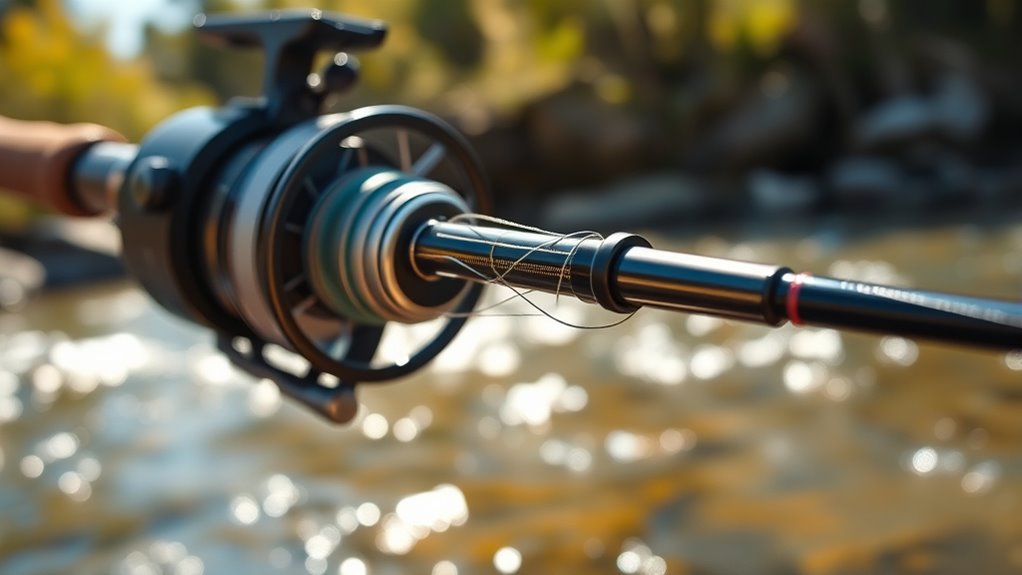
When might you push a rod beyond its rated line range? You might when you need to punch through heavy cover or when species and conditions demand extra abrasion resistance. Know that rod rating exists to balance bend, casting feel, and breakage risk; veering too far—like documented cases of 50 lb braid on an 8–12 lb rod—can snap blanks. If you decide to exceed the printed line weight, do so deliberately: reduce lure size, set a conservative reel drag, and favor controlled, low-stress retrieves. Match technique to the mismatch—avoid hard, sudden loads and pick favorable casting angles. Sensible deviations depend on cover, species, and your skill; treat rod ratings as guidelines, not guarantees, and accept higher failure risk. Many travel-friendly rods use a multi-piece design for portability and may handle slight line-weight variations better due to multi-piece design and construction choices.
Practical Pairings: Rod, Reel, Line, and Leader Examples
How do you put the ratings and rules into real-world setups? Pair a medium-action rod rated 12–25 lb with a 12–20 lb monofilament or 20–30 lb braid on a matched reel for balanced casting and control. Use a leader that stays within the rod’s rating—avoid leaders heavier than the main line rating to reduce stress.
If you choose heavier braid (like 50 lb) on that mid-range rod, tune drag and use softer hooksets; expect reduced casting efficiency and added strain. Many anglers accept that tradeoff for abrasion resistance, but always assess risk before casting.
For optimal performance, keep both line and leader centered in the rod’s range to balance power, control, and target species needs. Atlantic cod often inhabit rocky ledges at depths where heavier line and abrasion resistance become important.
Maintenance, Knot Choices, and Testing Your Setup
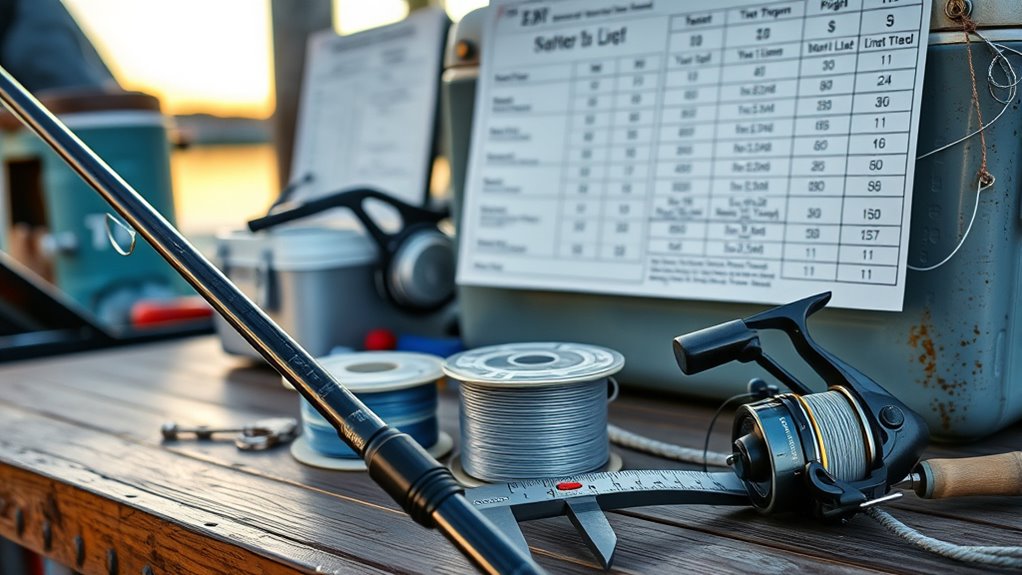
Keep your rig reliable by choosing knots that match your line type and testing them before you fish. Match knot choices to line weight and material: improved clinch for mono, Albright for leader-to-braid transitions, and a standard clench when practicing. Practice tying each knot until you can dress it neatly and snug without twists.
Test your setup with incremental stress: perform ten casts applying gradually increasing tension, then apply a static load to verify strength. Inspect line-to-leader connections after every outing for nicks or fray and replace damaged sections immediately. Use line conditioner on braided lines to reduce fraying and improve knot behavior. Consistent inspection, proper knot choices, and simple testing keep your rig dependable and prevent lost fish. Consider storing and transporting your gear in a compact, protective bag to prevent abrasion and sun damage to lines, especially when using inflatable or foldable boats with lightweight portability.
Final Thoughts
You’ll get the best results when your line choice complements your rod’s rating and the fish you’re after. Match line strength to rod power and lure/fly size, pick the right material for casting and sensitivity, and adjust for wading depth and rod length. Don’t be afraid to stretch ratings for specific situations, but test knots and setups beforehand. With smart pairings and regular maintenance, you’ll cast farther, hook better, and land more fish.


